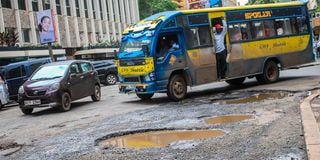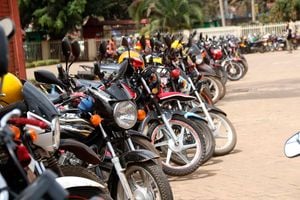Poor ranking a wake-up call for urban reform

Vehicles avoid puddled potholes along Mama Ngina Street in Nairobi on 7 January 2024.
What you need to know:
- The capital’s roads are a testament to neglect.
- The public transport system, which should be a lifeline for commuters, is largely dysfunctional.
In the recent Global Liveability Index 2024, the absence of any African city in the top 10—or even the top 20—raises important questions about urban living conditions on the continent. Dominated by cities from Europe, North America, Asia and Oceania, this ranking presents a sobering reality: many African cities, including Nairobi, face significant challenges that lower their liveability.
Nairobi is often portrayed as a vibrant hub, yet the city struggles under the weight of outdated infrastructure and systemic inefficiencies. Take the sewage system, for instance. Established during colonial times, it was designed to serve a fraction of the population it accommodates today. This antiquated system is now buckling under the pressure of a burgeoning urban population.
The consequences are visible and alarming—burst sewage pipes and openly flowing waste are common sights in the city. The smell of sewage permeates the air, and it wouldn’t be an exaggeration to label Nairobi as the sewage capital of the world.
The capital’s roads are a testament to neglect. Potholes the size of small cars litter the streets, posing serious hazards to drivers and pedestrians alike. These “craters” not only damage vehicles but also create the perfect situation for traffic accidents. As cities worldwide tout advancements in smart infrastructure and urban development, Nairobi is still grappling with basic road maintenance. It’s a shameful state of affairs that underscores a lack of investment and commitment to improving the urban environment for residents.
Public transport
The public transport system, which should be a lifeline for commuters, is largely dysfunctional. Instead, the streets are dominated by boda boda riders who weave in and out of traffic with reckless abandon. This not only endangers riders but also creates a frustrating experience for those trying to navigate the city.
As global urban centres innovate and expand their public transport systems, Nairobi remains stuck in a cycle of disarray, where safety and reliability are often sacrificed for convenience. Perhaps what is most frustrating is Nairobi’s tendency to cling to its status as the only city in the world with a national park within its boundaries. While this attribute may have once been a unique selling point, it feels increasingly tired and irrelevant in the context of the city’s broader challenges. It’s as if Nairobi’s identity is frozen in time, relying on its wildlife sanctuary to distract from pressing urban issues.
The need for a paradigm shift is clear. Instead of celebrating outdated attributes, Nairobi must address its urgent infrastructure and governance issues. This should begin with a critical evaluation of city planning, prioritising sustainable solutions that can be adapted to the realities of rapid urbanisation.
The absence of Nairobi or any African city in the liveability index is not merely a statistic; it is a call to action. It challenges us to confront the realities of urban life in the city and recognise the urgent need for reform. We can no longer afford to boast about our unique features while ignoring the basic amenities that should define a modern city.





